Messina 1347 - A Solo Review
10 Aug 2022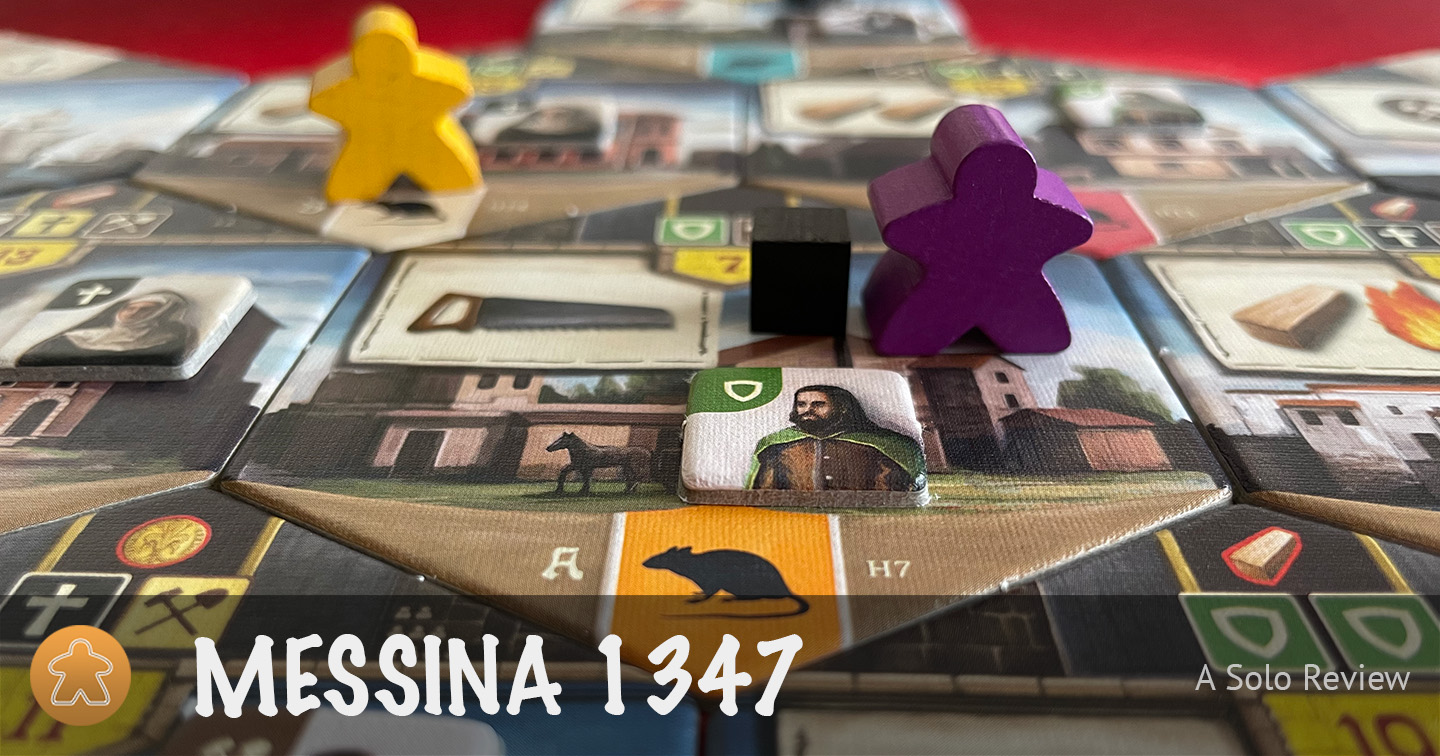
In the category of very aptly named games, I present to you Messina 1347, which takes place in—you guessed it—Messina in—yup, you guessed it again—1347, at the start of the outbreak of the black death plague epidemic. The disease came to Europe via merchant ships bringing not only luxury goods, but also rats infested with infected fleas. Do you have what it takes to survive this horrible period and secure the city?
Name: Messina 1347
Designer: Raúl Fernández Aparicio, Vladimír Suchý
Publisher: Delicious Games
Game type: worker placement/movement
What is Messina 1347?
In the game you play the role of one of Messina’s important and wealthy families. When the plague starts to spread via the rat’s fleas, you flee (hehe) the city towards your countryside estate, hoping to escape the disease. You provide shelter for other inhabitants of Messina, take care of the infected ones and fight off the plague in the city itself. If that sounds all nice and altruistic, don’t be fooled. The inhabitants have to work on your countryside estate and your end goal is to make a name for yourself so you gain influence and can dominate certain districts of Messina when the epidemic is over.
The main mechanic of the game is worker placement or movement. The modular game board is made up of hex tiles and represents Messina with its different districts. During the game you move your lieutenant meeples from hex to hex. On the hex you land on, you fight the plague if possible, execute the hex’s action and rescue the citizens on it. Depending on whether or not the hex was infected with the plague, the citizens either go into quarantine for two rounds, until they are healed, or directly to your estate. The citizens can be put to work in quarantine cabins or workshops where they will produce resources every round. If citizens stay in the estate, they can activate the action of the location they are in when one of your overseers moves along its path on your estate. Eventually citizens can also be used to repopulate Messina, claiming a district in your name.
All the various actions either give you resources, victory points or allow you to move up on one of the three tracks in the game. Moving up these tracks gives you certain in-game benefits and rewards you with victory points at the end of the game.

After six round the game is over and you calculate your total score.
How does it play?
Messina 1347 is played on two different game boards. One represents the city and is made up out of randomized hex tiles. The other one is the score board and contains seven stacks of building tiles and three tracks you can advance on during the game: the popularity track, the city track and the church track. (The score board also contains the score track, so just like the game, it is aptly named.)
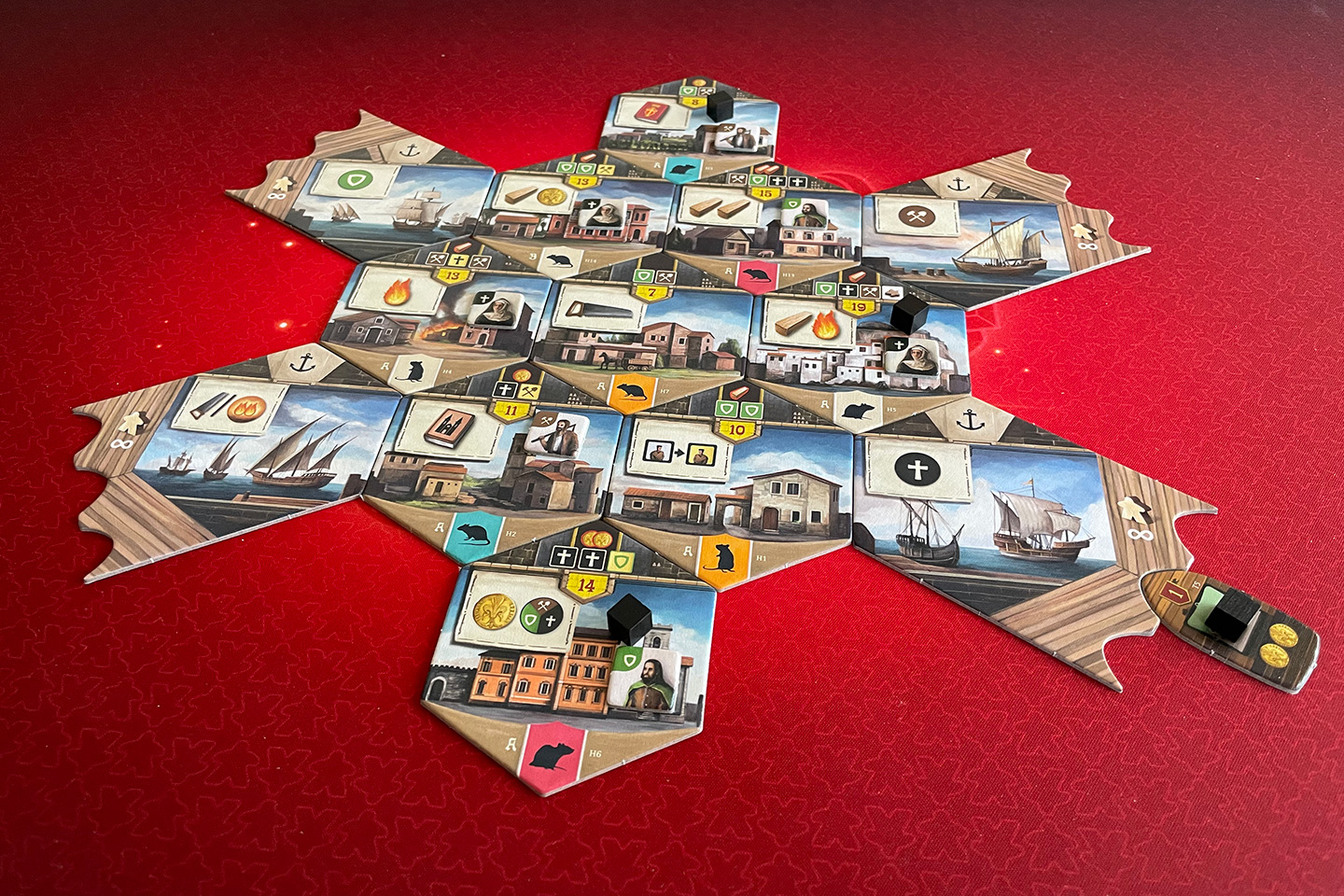
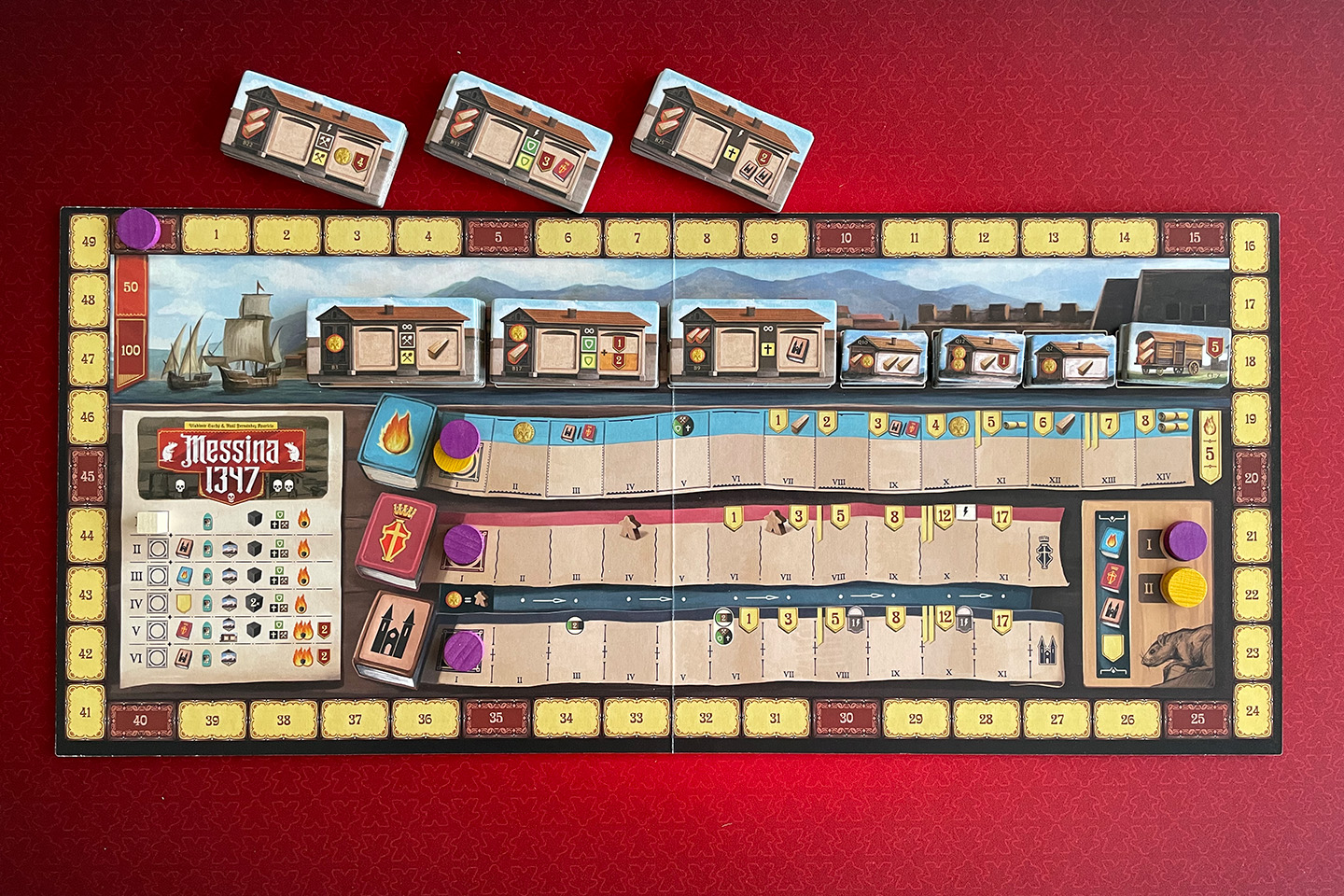
Beside those boards you will also need a player board and a scroll board. Both are double sided, with one basic side which is identical on all boards, and one advanced side which is unique. I sometimes have a hard time remembering which is which, because the basic side is labeled with an a and the advanced side is labeled with a b.
Before the game starts you have to do a few things that normally happen at the end of every round. You flip over one of the four harbor selection tiles, place a boat token at the dock of the indicated harbor of the game board and add a black cube to the boat. These black cubes represent the plague. Next you take the so called population wheel and advance it one space. It now shows you four things: a rat in a specific position, a color next to a nun, a color next to a craftsman and a color next to an aristocrat. Every hex tile on the game board has a rat in a colored area on the bottom. Looking at the population wheel, you place a plague cube on each hex containing a rat in that position, and nuns, craftsmen and aristocrats on hex tiles matching the colors. This represents the plague and the citizens randomly moving through the city.
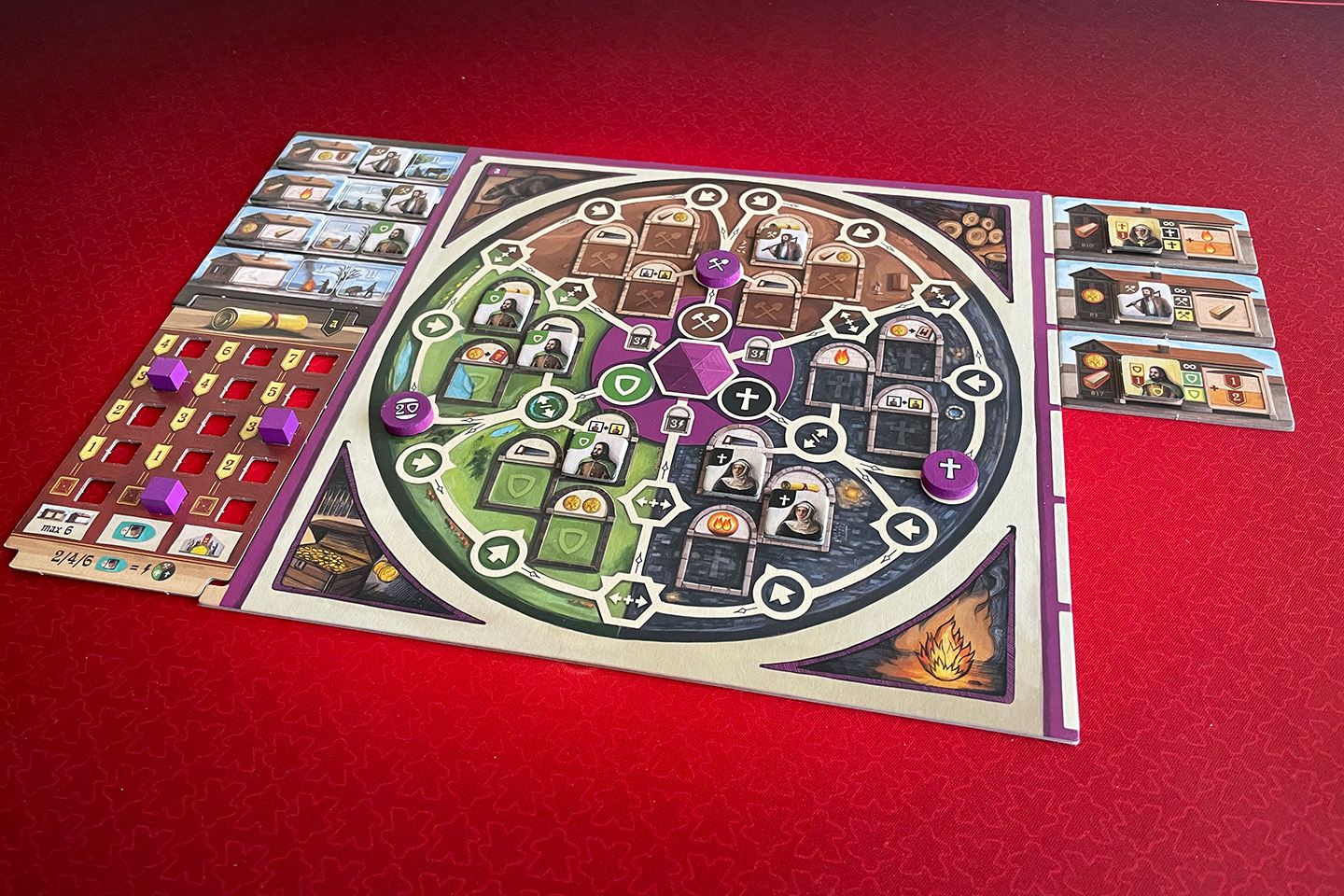
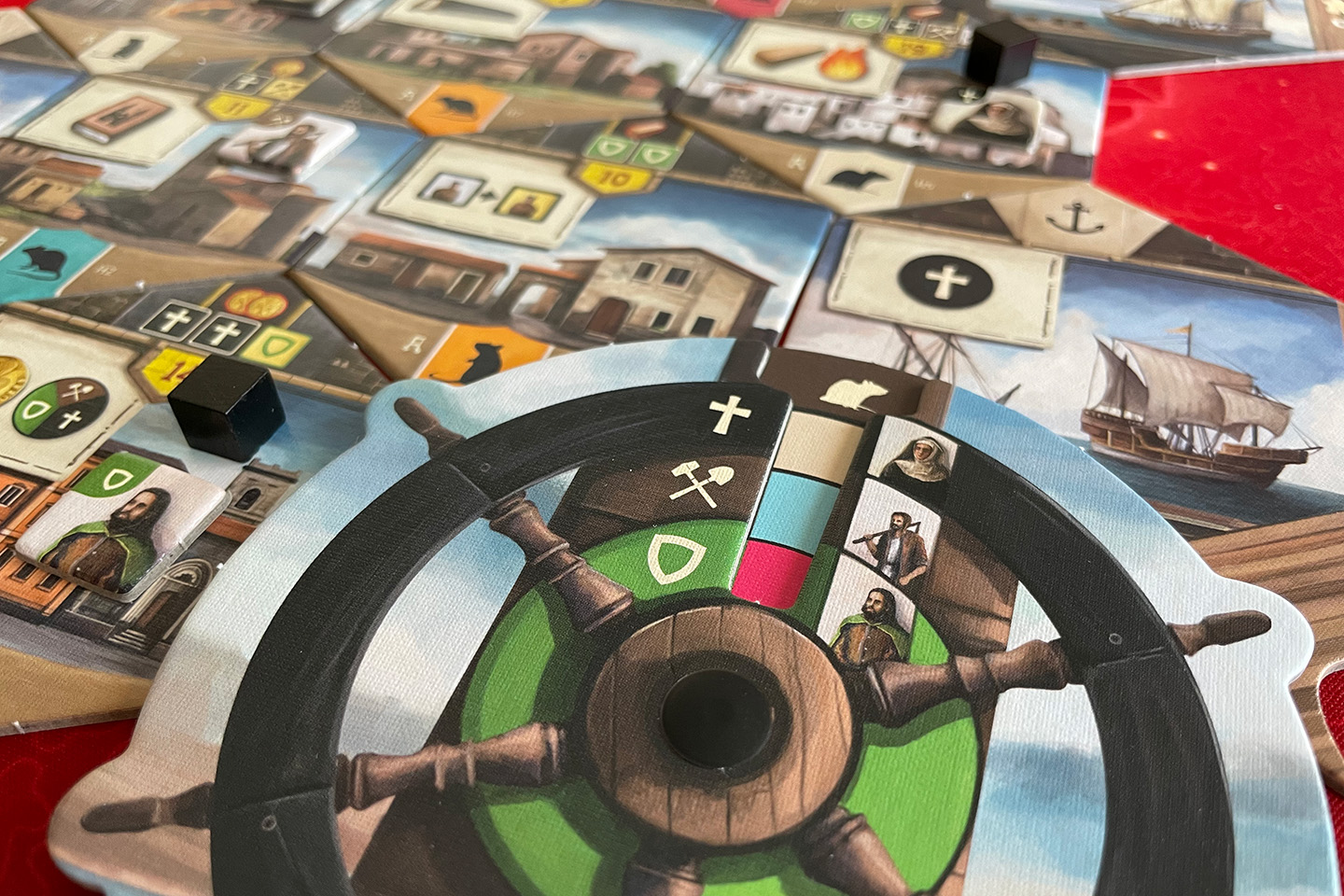
When that’s done you’re ready to play.
The game is played over six rounds and every round you get as many turns as you have lieutenant meeples. You start the game with three of them, but along the way you can acquire two more.
In each turn of the first round of the game you will be placing one of your lieutenants on the game board. At the end of every round you lay all of them flat on the hex they’re on. From the second round on, you will take a lieutenant that’s lying flat and put them upright on a hex that doesn’t yet have a lieutenant standing up on it. Staying on the same hex or moving to an adjacent hex is free. Moving farther is allowed, but it costs one coin per hex beyond an adjacent hex.
When your lieutenants move to a hex, there are few things you do. If there are any citizens (nuns, craftsmen, aristocrats) on the hex, you rescue them and move them over to your estate. If there is at least one plague cube on the hex, the citizens need to go into an empty quarantine cabin on your player board for two rounds. If there’s no plague cube the citizens can go directly into your estate, on a free space of the area that corresponds to their class. When that’s done you have the option of fighting the plague if it is present on the hex. You can pay one fire token to remove one plague cube. Removing a plague cube lets you advance one position on the popularity track, where reaching certain spaces gives you resources or extra actions and points at the end of the game. If you cannot remove all plague cubes, you get a rat token per plague cube that’s still left. These rat tokens give you progressively more negative points at the end of the game and there is no way to get rid of them. Finally you get to take the action depicted on the hex tile. I’ll go over the possible actions and what they mean below.
- Taking a resource indicated by the hex tile. These resources are either coins, wood, fire tokens or major fire tokens. Just like regular fire tokens, major fire tokens are used to remove plague cubes, but when you use a major fire token to do so, you can also remove one from an adjacent hex.
- Building. There are three things you can build in this game, using coins and/or wood: workshops, quarantine cabin improvements and wagons. Workshops are placed next to your player board and have space for a citizen of a particular type. When a workshop is occupied it produces whatever is displayed on the workshop during the production phase. Quarantine cabin improvements cover one of the quarantine cabins on your player board. As long as a citizen is in that quarantine cabin, it produces whatever is displayed on the cabin during the production phase. Wagons give you points when you build them and you need them to repopulate Messina.
- Advance on the city or church track. If you advance far enough on these tracks you get points at the end of the game. Additionally, the city track lets you gain two extra lieutenants and the church track lets you upgrade your overseers. You can also advance on either of these tracks at any time during your turn by paying an amount of coins equal to the number of lieutenants you have.
- Advance on your scroll board. Your scroll board shows three little tracks. The farther up a track you get, the more points you get for certain things. The basic side of the scroll boards for example, have tracks that give you points for each building, each boat and each hex tile you’ve repopulated.
- Move an overseer. I’ve already mentioned the part where you place citizens on your player board is divided into six areas, shaped together like flower petals: two for the nuns, two for the craftsmen and two for the aristocrats. In between those areas, starting from the middle and going through and around the areas, are paths for your three overseers. When you move an overseer you get to execute the action of a space that’s occupied by a citizen in an adjacent area. The farther along the path the overseer moves the better his effect becomes. It gets even better when the overseer is upgraded.
- Upgrade a citizen. This action lets you flip any citizen. Upgraded citizens generate one point in the production phase if they are in a workshop. Some workshops also produce better rewards when they have an upgraded citizen. “This upgraded nun will generate two fire tokens,” is something I never thought I would say.
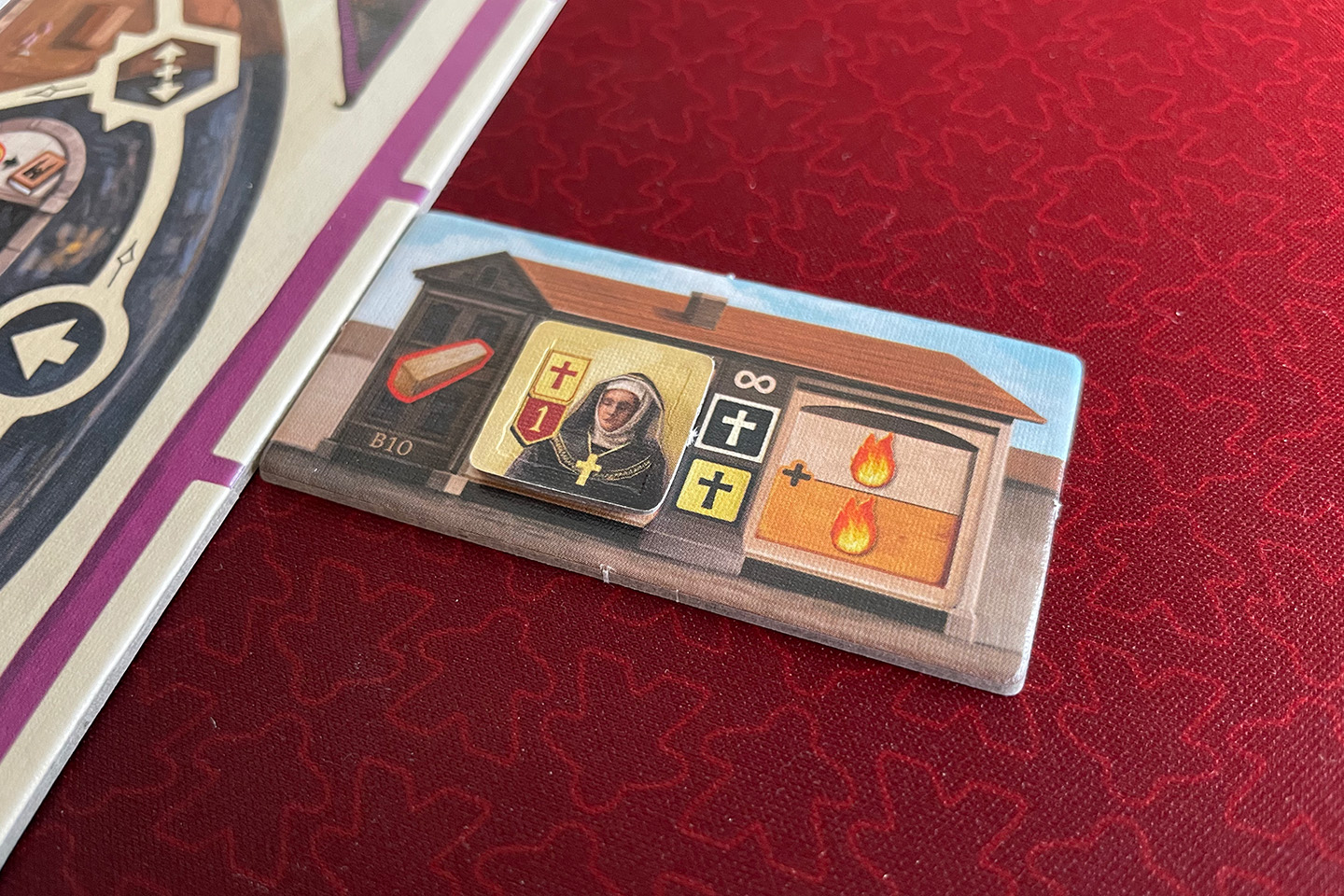
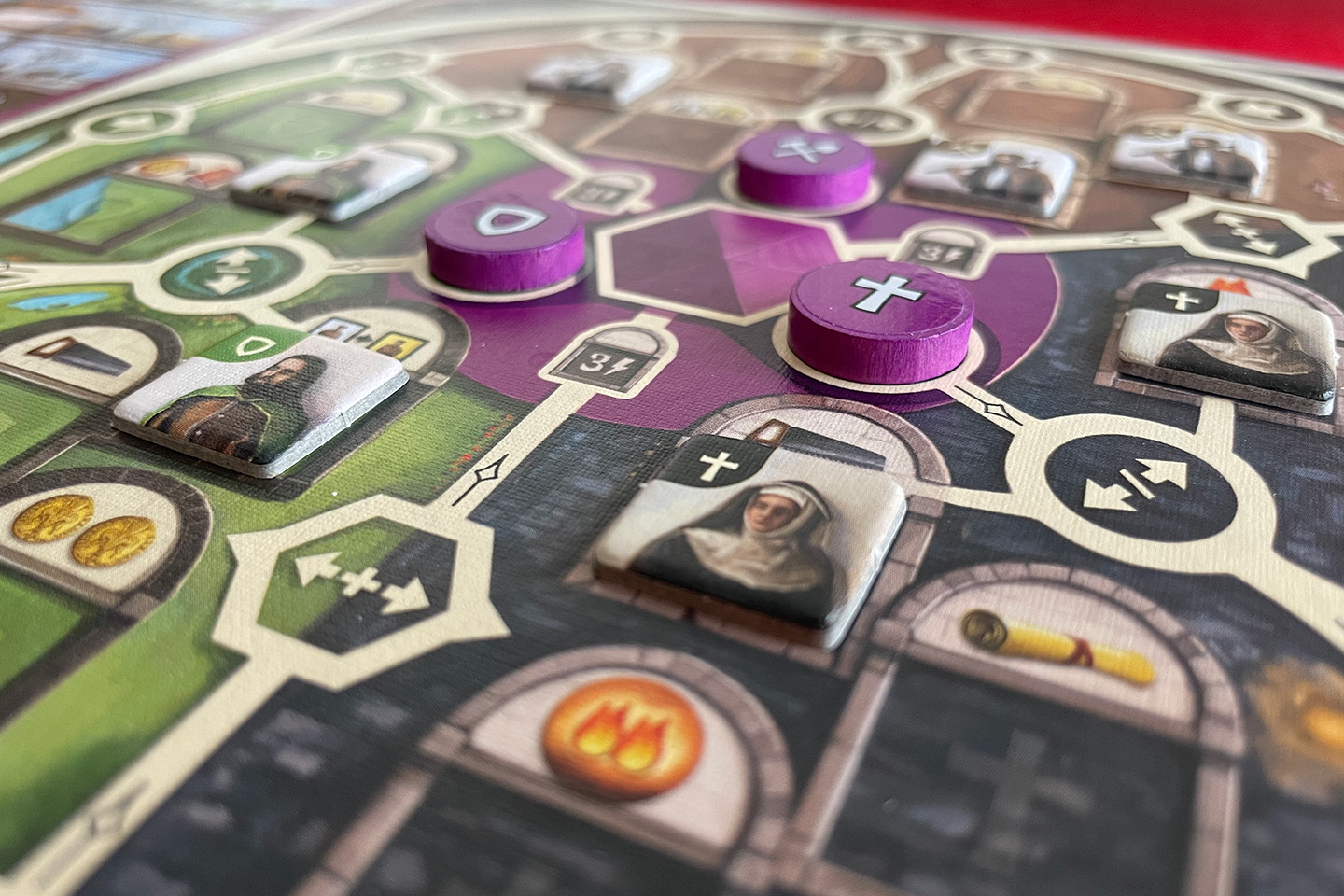
Instead of moving to a hex tile and doing the above things, there are also a few other things you can do:
- Move a lieutenant to a dock. If there’s a boat there, you can fight the plague on the boat and take the boat itself. This gives you coins and, at the end of the game, points.
- Instead of moving a lieutenant and executing the action of a hex tile, you can recall an unused lieutenant from the board. This gives you a coin and allows you to place the lieutenant on any available hex in the next round.
- Repopulate the hex tile your lieutenant moved to. Each hex tile has a repopulation cost indicated at the top. This can be any combination of coins, wood, citizens and even a lieutenant you have to sacrifice permanently. If you can pay the cost you can place one of your repopulation tokens on the hex tile. Whenever anyone, including you yourself, places a lieutenant on a hex tile you have repopulated, you immediately gain two points. On the flip side, whenever a hex tile you have repopulated gets a plague cube, you have to take a rat token. At the end of the game you score points for your repopulated hex tiles.
When you and the AI player have taken all your turns you move on to the production phase, where all quarantine cabin improvements and workshops that have a citizen produce their resources and points. After production the citizens in the first quarantine slot move to the second slot and the citizens in the second slot are considered safe and can move to your estate or to a workshop.
After the production phase, there’s a bit of upkeep to do before the next round starts:
- Move the round counter.
- Lay all lieutenants flat.
- Remove all citizen tokens from hexes that still have a plague cube.
- Reveal a harbor selection tile and add a new boat with a plague cube.
- Add an extra hex to the board.
- Rotate the population wheel and add new plague cubes and citizens to the game board.
After six rounds you tally up your score and check if you managed to get a new high score or not, because the AI in this game does not score points, turning this game’s solo mode into a BYOS—a beat your own score.
How does the AI work?
The AI in Messina 1347 is pretty simple. All it does is block you on hex tiles by placing its own lieutenants on them, and prevent you from taking workshops, improvements and wagons by discarding the top ones of the stacks. The AI player does not have a player board, it does not collect resources and it does not score points. It does not advance on the city or church track, it only has a marker on the popularity track. If you manage to beat the AI player on that track, you get extra points.
The AI player starts with three lieutenants just like you, but since it does not use the city track, it needs another way of getting extra lieutenants. The game solves this by giving the AI player its fourth and fifth lieutenant automatically in the fourth and sixth round respectively.
Another consequence of the AI player only using the popularity track is that the game also needs a different way of determining who is the first player in a round. In a multiplayer game the player order of a round is determined by the order the players are in on a specific track (e.g. the city track in round two, the church track in round three, …). Simple is the keyword in this solo implementation: you go first in the odd rounds, the AI goes first in the even rounds.
Running the AI is equally simple. The game comes with 14 small solo tiles, each showing a hex tile and possibly an action as well. You place the solo tiles in a face down stack. On the AI’s turn you flip over one of the solo tiles and place one of its lieutenant meeples on the hex tile indicated by the solo tile. If that hex tile is not (yet) in play or if it is occupied by one of your lieutenants, you keep flipping over solo tiles until you get one that corresponds to an available hex tile. Next you execute the action on the solo tile, not the one of the hex tile. There are five different actions the AI can take:
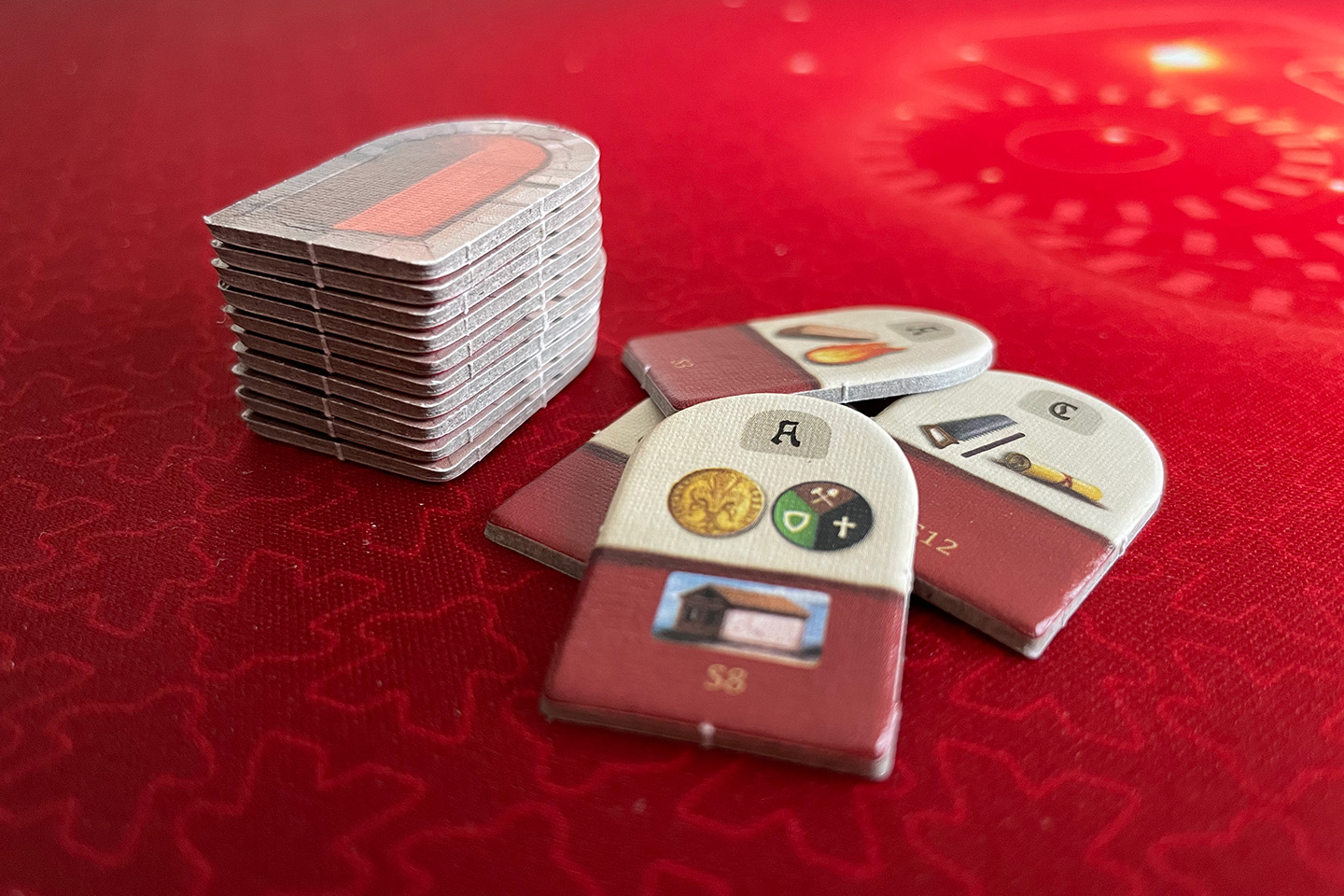
- Nothing. Some solo tiles don’t have an action. In this case the AI does not take an action after placing its lieutenant meeple.
- Take the top wagon from the wagon stack and remove it from the game.
- Take the top workshop of the indicated type and remove it from the game.
- Take the top quarantine improvement of all quarantine improvement stacks and remove them from the game.
- Take a boat tile from the dock closest to hex the AI player just placed a lieutenant on and remove it from the game.
If there are any citizens on the hex tile the AI placed a lieutenant on, you return them back to the supply. If there is at least one plague cube on the hex tile, the AI player removes one of them and advances a place on the popularity track.
That’s all there is to it! After six rounds you calculate your final score. According to the rule book 130 points is a good score. Or 140 if you are using the advanced variant.
What does it look and feel like?
The wooden components in this game are OK, nothing special. Standard cubes, discs and sticks. What I like less is that you have to put stickers on the wooden overseer discs. I really don’t like stickers on wooden components in games, but that could just be me since I see a lot of people purchasing custom stickers for all kinds of wooden components for all kinds of games. The wooden rat tokens look nice, but because they don’t have tails they don’t immediately remind me of rats.
The cardboard is of medium thickness. Unfortunately the punchboards in my copy were not punched all the way through and quite a lot of the citizen tokes got a bit damaged when punching them out. I managed to trim things using a tiny pair of scissors, but it’s still a shame.
Art is subjective and I don’t have a strong opinion about the one in Messina 1347. It’s not bad, but it’s not the prettiest game either. But it doesn’t bother me or distract me while playing the game, so that’s OK. One thing that is a bit annoying is that the art on the hex tiles can be quite busy, which often makes it hard to spot citizen tiles on a first glance.
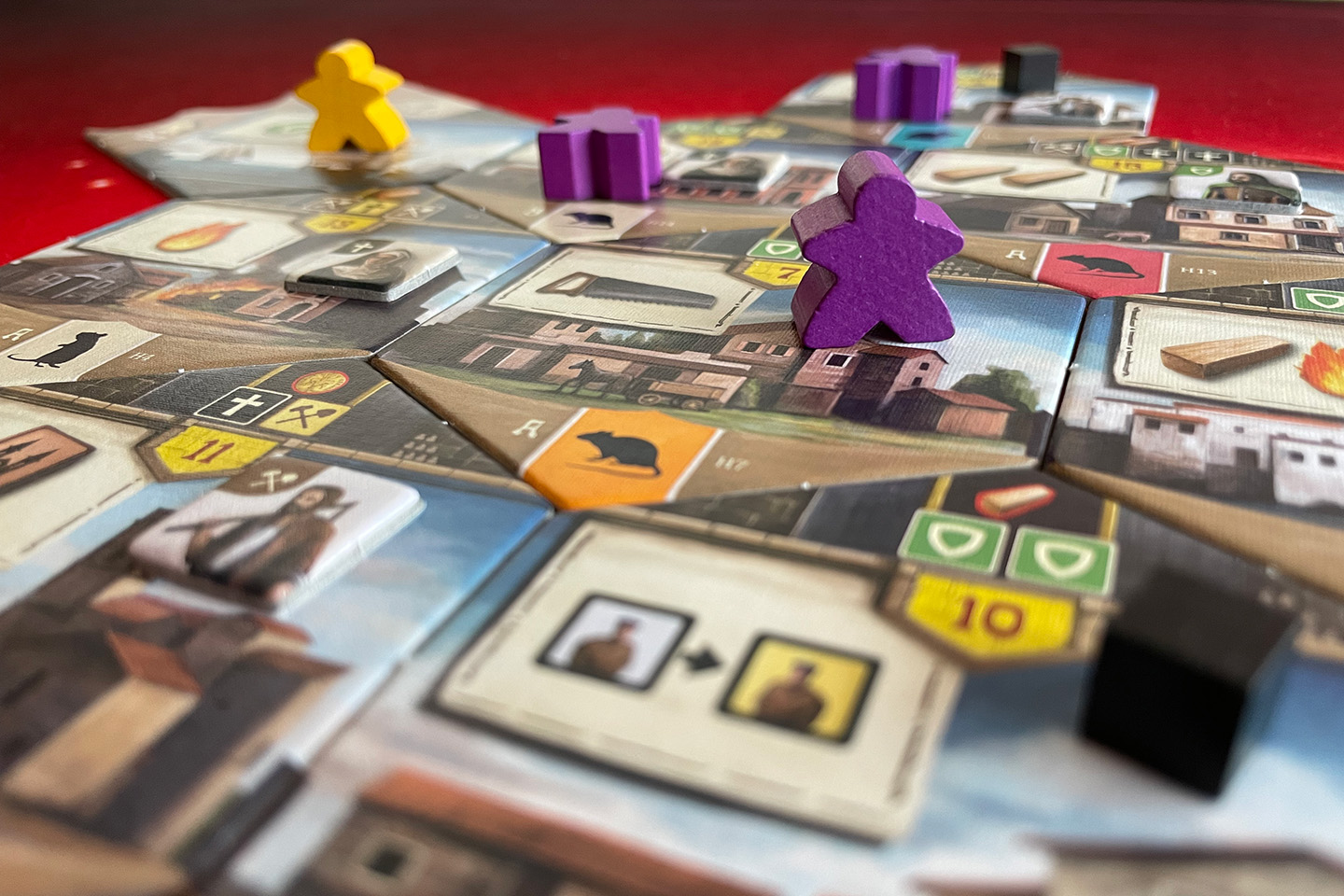
It would have been nice if the game had cards instead of tiles for the AI player. The tiles a pretty small and stacking them up face down, and especially shuffling them, can be fiddly. The tiles are actually re-used components. The front (or back, depending on how you look at it of course) shows a closed door and in a multiplayer game they are used to cover up one time actions on the advanced side of the player boards. (This means you have to use something else to cover up those spaces in a solo game.) So my guess is that they re-used these tiles to save costs? I’m not sure. Luckily someone on BGG was nice enough to make custom solo cards. (You need to have a free account on BGG in order to access the files.)
How much time does it take?
There are a lot of different components to sort out in different stacks. If you use only a few bags you will need some time sorting everything out at the start of the game. If you use more bags, you will need time sorting everything out at the end of the game. I started using various different containers to reduce setup and teardown times. I think those parts take me around 10 minutes now.

The game length itself is highly dependent on how prone you are to analysis paralysis because this is tight game that requires you to think things through. When looking at the people I sometimes play games with, I typically take the longest for my turns, but I can still play a solo game of Messina 1347 in about 60 minutes.
So everything included I would say 60-75 minutes would be accurate for most players.
What is my verdict?
Alright, let’s start with the things I like less about this game.
The first things I do when I get a new game are punching everything out and organizing it back into the box, and reading the rulebook. With Messina 1347, both of these things gave me a below average first impression of the game.
As I already mentioned earlier in my review, I don’t have an issue with the cardboard quality in itself, but I really did not like the punchboards. There are over 70 small tokens to punch out and quite a few of them did not come out cleanly. I don’t think I’ve ever had to punch out a game this carefully and still I wasn’t able to prevent damage.
Next up is the rulebook. It somehow manages to make the game seem a lot more complicated and complex than it really is. I actually read it four times front to back because I kept feeling I did not understand the game well enough to start playing. Halfway through my first playthrough I realized the rules were a lot simpler than the rulebook made them appear. Another thing I don’t really like about the rulebook is that it’s a bit ambiguous or vague around certain topics. I had to look up a fair amount of things on the BGG forums. All the things I wanted to know were already asked by other people, so it looks I’m not the only one requiring clarification on those topics. In fact, while writing this review I decided to check the forums again. Turns out I’ve been playing all this time without a specific rule (you need to shuffle the AI tiles at the start of every round), because it is simply not mentioned in the rulebook.
The variability in this game is something I’m on the fence about. Either I am not good at this game (which my scores kind of confirm), or it gives a false feeling of variability. On the surface it looks like there might be a lot of different things to try or strategies to go for, but in reality I think there are things you always have to do in order to do well. You cannot ignore fighting the plague because climbing up on the popularity track is just too good. You can’t focus on both the city and the church tracks, so you will have to pick one, meaning there two ways to go. I don’t think you will ever get a good score without doing at least two or three repopulations. And since the game is so tight and requires efficiency, when you need to focus on those things, there seems to be little room for other things. Again, this something I’m on the fence about, because it could just very well be me and not the game.
What I do like about this game is that everything is very tight and you have to be really efficient with what you do. You want to do a lot, but you are limited in how much you can do, so using your lieutenants and overseers efficiently is key here. It feels like a really interesting and crunchy puzzle to solve, because of the randomness of the hex tiles, the citizens and the plague cubes. Now that I think of it, this kind of reinforces my idea that the variability in this game mainly comes from the randomness of the components and not from the different strategies you can explore.
I also like that the game feels pretty thematic. The boats arriving with the plague, the plague and citizens moving randomly through the city, possibly infected citizens needing to be quarantined for two rounds, … I think that’s all well thought out.
The fact that you can play in about an hour is a plus for me. I don’t always have time for games that take an hour and a half or two hours, so something like Messina 1347 is definitely welcome in that category.
Another positive thing is the clear iconography and the little reminders of when to do what. There are nice player aids, but the score board also has a little round tracker where for each round is displayed what you need to do. For example, in the fourth round you need to add plague cubes twice, in the fifth and six rounds you need two fire tokens to fight the plague, but doing so also gives you two points and in the sixth round you don’t add new citizens to the board. All that is shown in an easy to understand way.
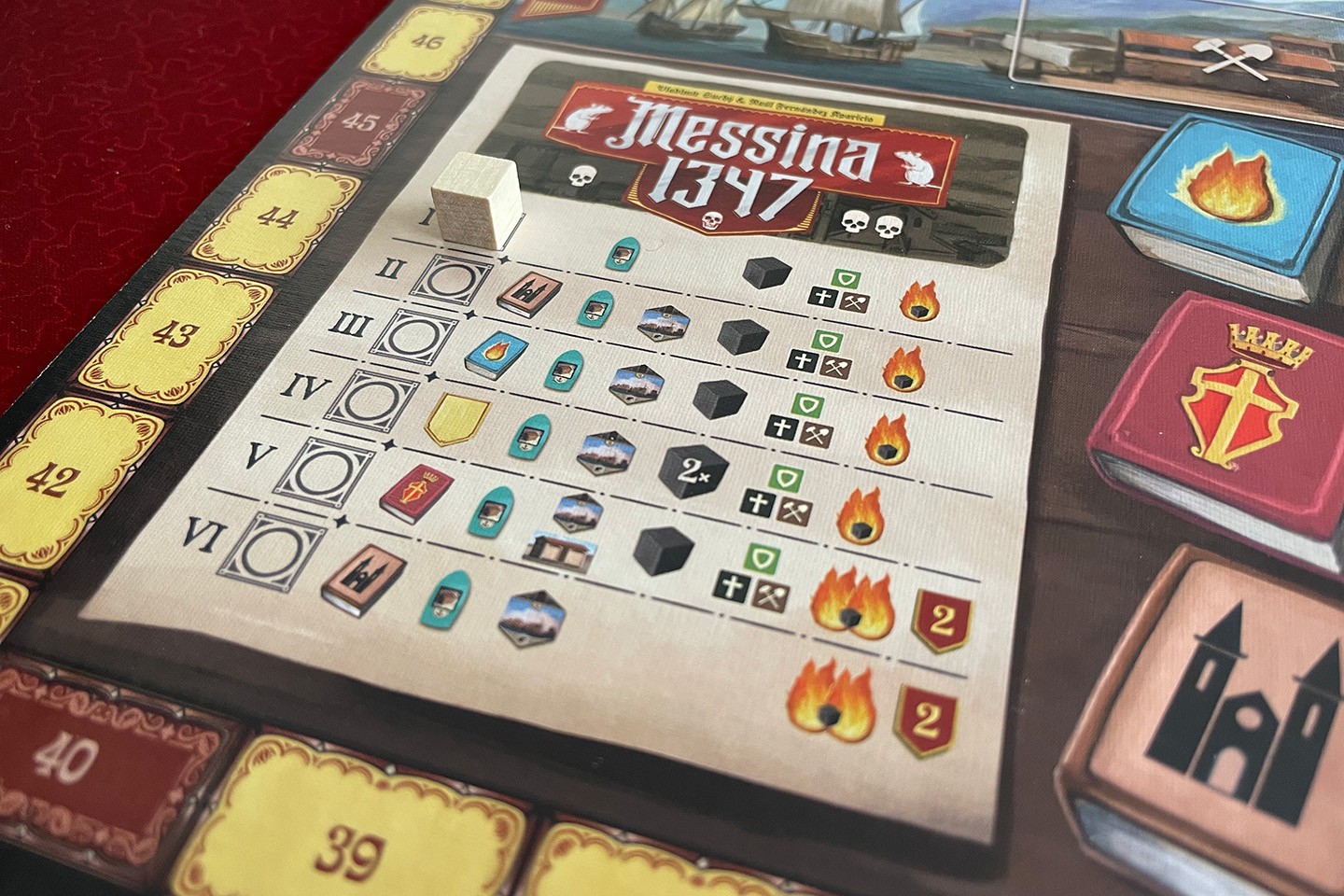
Now, while I do enjoy the game while I am playing it, I don’t often choose it when I’m choosing a game to play and I honestly have no idea why. Maybe it’s because it gives me that feeling of false variability? Maybe it’s because I can’t seem to get better at it? I don’t know.
I’ll probably keep Messina 1347 a while longer to see if it can change my mind, but I don’t see me holding on to it forever.
Score
To make things easier for myself, I use the same scoring categories Board Game Geek uses.
Comments
I'm sorry, I don't support comments on my website. If you want to discuss the game or my review, feel free comment on this dedicated Instagram post or my review on BGG.